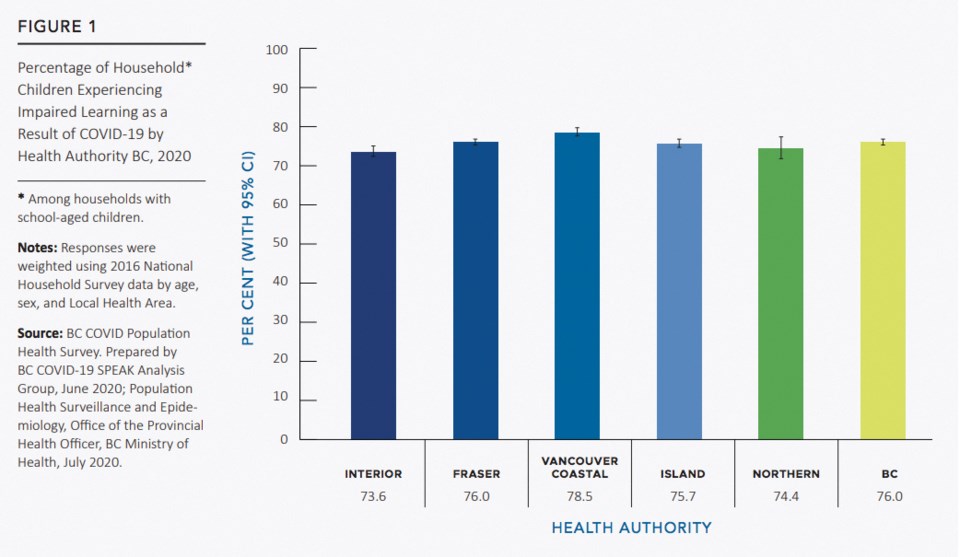Most students’ learning was impaired when they were shut out of school during the lockdown and transmission at schools is not any riskier than in the community at large, according to a BC Centre for Disease Control (BCCDC) report.
Released in late September, the organization concluded “schools are not at higher risk of COVID-19 transmission than community settings.”
The study reviewed evidence from journals, data and other sources available up to Aug. 18.
Transmission among children is lower than adults, according to its analysis, with evidence suggesting children in school and daycare settings are consistently less likely to become infected than adults, and “contract tracing studies of school outbreaks have identified limited transmission by children to other household members, other students or staff.”
It also found the younger the child, the less likely they are to transmit the disease.
In Canada as of Aug. 5, there had been one death among the 9,302 cases of persons 19 and under.In B.C., 6.2 per cent of residents diagnosed with laboratory tests are 19 and under, while that age group makes up 20 per cent of the population.
The study said the data on the link between reopening schools and COVID-19 transmission remains “limited,” but transmission in schools will depend on the rate of transmission in the greater community.
“Outbreaks in daycares, schools, and summer camps were all reported when either community prevalence was high and/or when public health measures were not followed. Cases of increased transmission in schools generally involved older student populations in instances when community transmission was high,” said the report.
Within school settings the study found the highest risk of transmission is between staff rather than from students to staff.
The information comes as health authorities continue reporting exposure events at schools on their websites. As of Oct. 5 there have been no reported exposures at School District No. 46 (SD46) schools.
Unintended effects
Medical health officers and school districts have reported the unintended consequences of closing schools as a reason to reopen, and BCCDC’s analysis also bears that out, listing a number of adverse effects related to the lockdown.
For starters, a B.C. survey conducted over the summer showed that 76 per cent of respondents said their children experienced “impaired learning” during the school closure last March – and in the Vancouver Coastal Health region that number climbed to 78 per cent.

The same survey found 60 per cent of respondents reported increased stress.
It also found mothers were disproportionately affected, through job losses, reduced hours and more time spent caregiving. Indigenous households, single mothers and recent immigrants were the most likely to experience stress, as well as parents with special needs children who didn’t have as much respite care.
However, BCCDC also acknowledged other studies that show children experience stress because of school, with a noted increase in “emergency mental health visits” during back-to-school periods, and more visits during the school year than in the summer.
Federal data showed an up to 30 per cent increase in family violence in some regions of Canada and the study noted that “careful assessment is required to determine whether family violence and abuse towards children has intensified in B.C.” It did, however, note that in April and May there were 23 per cent fewer child protection reports issued to Ministry of Child and Family Development, likely because teachers weren’t monitoring children at school.
No B.C.-specific data showed the effect of school closures on food security, though the study noted anecdotally there was a considerable increase in families relying on food provided through school programs.
The study also noted it needed more direct input from children, since its survey relied on parents.
SD46 director of instruction and inclusive education Kate Kerr told Coast Reporter the findings underscore the importance of “face to face supports for our children, especially those with diverse abilities.” She said the district has been “proactive and diligent” about supporting “diverse learners.”
“Ideally, we want all of our students, especially those with diverse needs, to be back at school so that we can provide the safe space and specialized services in an optimal environment. However, we also understand that for a variety of good reasons some students need to stay at home,” she said. “We continue to be creative whichever option our families choose to provide equitable access to education, resources, tools and supports.”
The report can be read in its entirety here: http://tinyurl.com/y5rkuqxs



